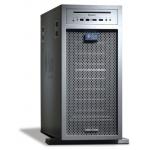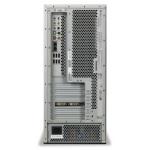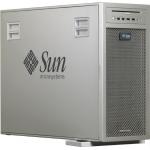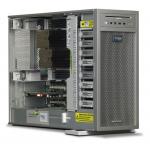Sun M2: Mission Accomplished
Sun's new Ultra 40 M2 Workstation impresses with speed and power, but it comes at a price.
Latest News
March 1, 2007
By Mark Clarkson
When I heard the second generation of Sun’s Ultra 40 Workstation was soon to be released, I couldn’t wait to give it a whirl. The first was impressive (see July 2006 DE), so the new and improved M2 version held a lot of promise.
The PackageMy new Ultra 40 M2 came with twin dual-core 2 AMD Opteron 2220SE 2.8GHz processors, 8GB of ECC DDR2-667 system RAM (the system supports up to 16GB), and a single 500GB SATA 7,200 RPM drive. (The Ultra 40 M2 supports both SATA and SAS.) Its NVIDIA Quadro FX 3500 graphics card, though not quite top of the line, was more than up to the tasks I gave it, one of which was processing a model with about a million polygons.
 |
| Sun Ultra 40 M2. |
Ultra 40s come preloaded with Sun Solaris and tons of development tools but, I must admit, I didn’t look at those. And while the Ultra 40 M2 doesn’t ship with Windows installed, it does support Windows, so I tested the system using 64-bit Windows XP Pro.
Sun also sent along one of its 24.1 in. flat-panel LCD monitors. This is the second Sun LCD monitor I’ve tried, and they’ve both been fantastic in terms of brightness, contrast, color, clarity, and viewing angles. Pricey, but fantastic.
Another Solid Case
I’m delighted to report that Sun has made virtually no changes to the Ultra 40 case. If you’re sliding the M2 into a space recently vacated by an older system, you’ll find all the plugs and ports in the same locations, and all the exterior dimensions unchanged.
The Ultra 40’s case is big, sturdy, and metal, with a matte silver finish. It’s a case you can comfortably put your feet up on, and which will easily shrug off the normal kicks, bumps, and bangs that come from living in a crowded room, or under someone’s desk. There are no sexy curved parts taking up extra inches of shelf or desk space, and no plastic bezels or hinged goodies to snap off. The minimalist slot-load DVD-RAM drive doesn’t even have a tray to break.
The front looks more fashionable than the back, but both are basically grills for airflow. The face sports a pair each of USB and FireWire ports, headphone and mic jacks, and the power and DVD eject buttons. A single green LED tells you the system’s on. I really like the low-key design but I don’t think drive and network activity lights would be overly gauche.
 |
| Sun Ultra 40 M2. |
Around back you’ll find four PCI Express x16 slots (two x16 electrical, two x8 electrical), a single 32-bit/33MHz PCI legacy slot, another six USB 2.0 ports, and five-channel sound, all clearly labeled. On the Inside
Squeeze two large clasps to pop the outer case open. An illustrated maintenance guide affixed to the inside surface provides a system map, a motherboard connector layout, and color-coded instructions for everything from adding RAM to replacing the motherboard.
Within there’s a lockable second transparent inner cover that allows people to gaze in and check motherboard error codes and whatnot without actually having access to the innards. A second set of clasps releases that shield.
 |
| Sun Ultra 40 M2. |
Three big 125mm fans, mounted in a detachable ‘tray,’ sit behind the drives, pulling air in across them before dumping it on the motherboard. Again, everything is clearly labeled. Here are just two examples: A sticker on the fan tray illustrates exactly how to remove it if you need to get at the drives and a caution sticker below the drives warns you not to mix SAS and SATA.
The 1,000-watt power supply hides at the very bottom, clear of the motherboard. This helps bring the center of gravity down and helps prevent tipping.
The motherboard, built around the NVIDIA nForce Professional 3600/3050 chipset, is fully exposed. Each dual-core Opteron processor has its own towering heat sink and dedicated fan. The RAM slots are now enclosed in their own little corral with a dedicated fan on top. Everything is exceptionally clean and neat.
There are none of those hydra-headed power cables running everywhere getting in your way. The fan tray plugs into its own socket. The CPU and RAM cooling fans pick up their power from the neighboring motherboard. You never have to push one cable out of the way to get at something else.
Do you like working inside of computers? Well, I hate it, and that’s why I love this system. Because it’s built to have me in and out in the absolute minimal time so I can get back to work.
So How Fast is It?When I looked at the Ultra 40 last summer, I put it to work importing and rendering IGES files of a prototype computer. I gave the M2 the same tasks to see if it could improve on the results. Keep in mind that the new tests were run on a 64-bit version of Windows; I tested the original Ultra 40 using 32-bit Windows.
 |
| Sun Ultra 40 M2. |
Loading a mammoth, 785,000-component, IGES file into Rhino took 13 minutes on the Ultra 40; the M2 finished up in 11 minutes and 40 seconds. That’s 11.5% faster, the smallest measurable improvement I saw.
Rhino only uses a single processor core when importing. Rendering in Lightwave, which can spread the workload among all four cores, ranged from faster to much faster. Rendering on a single core was around 37% quicker, while rendering on all four cores was only 15% quicker. But, after carefully tweaking the number of threads and instances, my very best speed dropped from about 54 seconds per rendered frame on the Ultra 40, to about 25 seconds per frame with the Ultra 40 M2: Faster by more than 100%. Once you figure out the best way to load up the processors and memory, this machine can really fly.
The Ultra 40 M2 is a powerful brute, pricey, but powerful. Despite its (necessary) abundance of fans, the Ultra 40 M2 is the quietest system currently running here in my basement. The system I reviewed goes for $7,435 sans monitor. The Ultra 40 M2 starts at $2,795.
Mark Clarkson, a.k.a. “the Wichita By-Lineman,” has been writing about all manner of computer stuff for years. An expert in computer animation and graphics, his newest book is Photoshop Elements by Example. Visit him on the web at markclarkson.com or send him e-mail about this article by clicking here. Please reference “Sun Ultra 40 M2” in your message.
At A Glance: The Sun Ultra 40 M2
My review system came equipped with:
> Two AMD Opteron 2220SE (Dual Core, 2.8GHz)
> 8GB memory (8x1GB DDR2-667)
> 500GB SATA 7,200-RPM HDD
> NVIDIA Quadro FX 3500 graphics
> DVD RAM
> Eight USB 2.0 ports
> Two IEEE 1394a ports
> High Definition Audio 1.0 (10 ports)
> Two 10/100/1000 BaseT Ethernet ports
> Price as tested: $7,435
Sun 24.1-inch LCD Display
> List Price: $1,595
Sun Microsystems, Inc.
Santa Clara, CA
You can read more about the Ultra 40 M2, or sign up for a free 60-day trial, by clicking here.
Subscribe to our FREE magazine, FREE email newsletters or both!
Latest News
About the Author
Mark ClarksonContributing Editor Mark Clarkson is Digital Engineering’s expert in visualization, computer animation, and graphics. His newest book is Photoshop Elements by Example. Visit him on the web at MarkClarkson.com or send e-mail about this article to [email protected].
Follow DE





